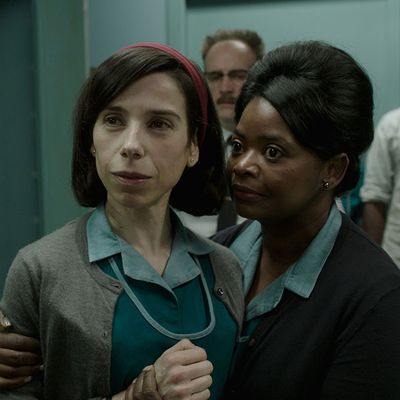
Here at the Toronto International Film Festival, there are posters for an upcoming Guillermo del Toro–curated exhibit called “Influences” that will let you sample the movies and books and music that fed the director’s fervid imagination. I can guess what’s in it after seeing his Venice Film Festival–prize-winning The Shape of Water, which screened in Toronto and opens commercially in December. The Creature of the Black Lagoon, with Beauty and the Beast and E.T. (and Splash?). The Hunchback of Notre Dame. The excellent British monster film Death Train (a.k.a. Raw Meat), which del Toro talked to me about 13 years ago before a Lincoln Center screening, citing subterranean tunnels as objects of fascination when he was growing up in Mexico City. Musicals, especially with tap or dancing in the moonlight. Whimsical Italian comedies. Anti-fascist melodramas. Fetishistic Biblical epics. Plus things I’ve missed, no doubt. They’ll be written about in articles I’ll somehow forget to read.
In The Shape of Water, del Toro’s influences have been distilled and reassembled into a stylized Girl Meets Gill Man fairy tale that shimmers with its filmmaker’s love. There’s so much love for its various antecedents that the movie feels a bit secondhand. It’s set in Baltimore in ’62, still the height of the Cold War, when the U.S. and Soviet militaries are aggressively working to discover ways — including supernatural ways — to achieve world domination. The heroine, Eliza (Sally Hawkins), is a cleaning woman in a top-secret underground facility that’s the setting for just that sort of research. One day an Amazonian Gill Man (known as “the Asset,” played by Doug Jones) arrives in a tank in the custody of an agent named Strickland (Michael Shannon), who talks about how the creature is an affront to God, not “being made in His image.” He’s also fond of using an electrified cattle prod, which he refers to as his Alabama how-dee-doo. The way he used it reminded me of how southern policemen beat black civil-rights protesters. Perhaps what reminded me was footage on nearby TV screens of southern policemen beating black civil-rights protesters.
Did I mention that the heroine is mute and suffers from the feeling that she’s “incomplete?” She was apparently mistreated as a child — her vocal cords were cut, gross — and drowned and was resuscitated, so she already has a relationship of sorts with the creature in the water tank. (It’s fate, she signs.) She has a strong sexual appetite: We see her pleasure herself in the bathtub in the mornings. Meanwhile, he’s not unattractive. No visible sex organs, but slender and broad-shouldered and tall. The pale face in the middle of those undulating gills has the alien-reptile handsomeness of Benedict Cumberbatch.
I should mention that the lovable, mute heroine lives (above a movie theater) with a lovable, talkative gay painter (Richard Jenkins) who keeps trying to create Norman Rockwell–like illustrations for an advertising firm that has let him go (because he’s gay?). And that Eliza has another natural ally in her fellow cleaning woman, Zelda (Octavia Spencer), who chatters away about her lazy, good-for-nothing husband. So you have a poor mute woman, a poor black woman, a poor gay man, and a so-called freak of nature versus a God-and-country white fascist who buys a Cadillac because it represents “the future” and is shown in bed mechanically grunting over his impassive blonde Stepford wife. Did I mention that he and his five-star general boss want to dissect the Gill Man rather than keep him around? Talk about stacking the deck.
I didn’t fight The Shape of Water off — I tried to surrender to its romance. The dank, rusty industrial settings suggest a sunken ship, but one that can be magically transformed by the creature’s bioluminescence. Hawkins doesn’t overdo the ingenuousness: Her Eliza is sly and subversive, with an energetic libido. Shannon invests the disgusting Strickland with every drop of dignity he can muster, almost making this deluded zealot a tragic figure. Jenkins is a sweetheart. Michael Stuhlbarg is movingly conflicted as a doctor with a big secret. But the characters are always drifting back and forth over the line that separates archetypes from stereotypes. (See Brad Bird’s Cold War–set The Iron Giant for the converse — the stereotypical-made archetypal.) And while Del Toro ups the gore and — disarmingly — the sex quotient, the story goes exactly where you think it will. It’s an utterly lovely, complacent movie, too comfortable with itself to generate real dramatic tension.
A lot of people find it transporting, though. And kids would have been a good audience if not for the nudity, copious gore, and soft-core fish porn. Are there still laws against bestiality? Has James Woods tweeted anything?


